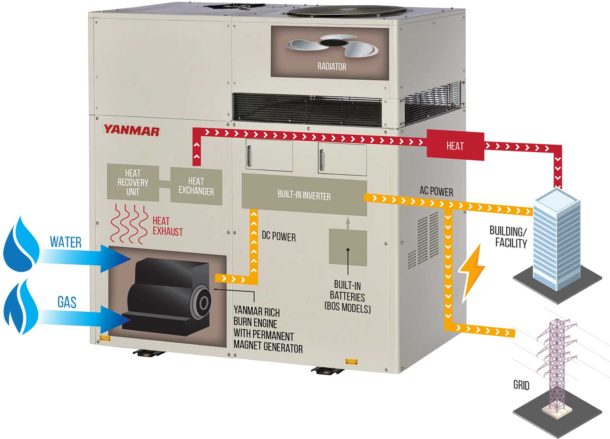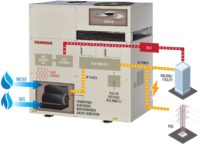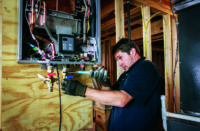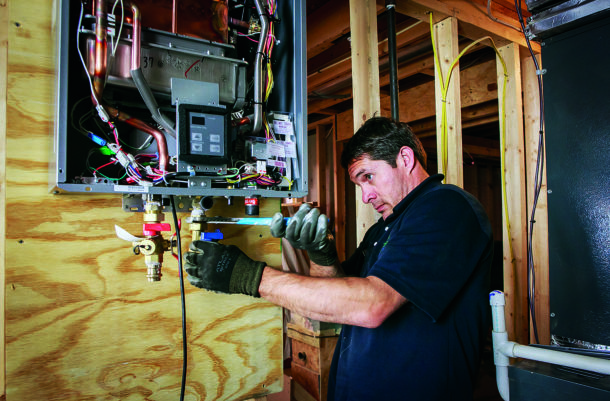Propane and solar can work together to play a large part in national energy conversation Solar Appreciation Day is Friday, March 11, and the Propane Education & Research Council (PERC) is sharing ways that construction professionals and their customers can use propane and solar energy together to reduce their carbon footprint. “Solar PV, an intermittent Read more
Bryan Cordill

Propane and solar can work together to play a large part in national energy conversation
Solar Appreciation Day is Friday, March 11, and the Propane Education & Research Council (PERC) is sharing ways that construction professionals and their customers can use propane and solar energy together to reduce their carbon footprint.
“Solar PV, an intermittent electricity producer, is a low-emission, renewable energy source,” said Bryan Cordill, director of residential and commercial business development at PERC. “However, relying only on solar power can be difficult in regions due to a variety of reasons like the amount of daylight hours during winter or tree cover. Propane can help.”

Currently, propane is used by nearly 12 million U.S. households for home heating, water heating or cooking, and by thousands of American businesses. The more propane appliances a business or home has, the lower the amount of solar power needed to operate lights or charge cell phones. Hybrid systems that run on propane and solar can be tailored to a project’s unique needs, providing lower first costs and reduced ongoing energy costs and emissions.
Large, sustained power outages have continued over the last two decades according to the U.S. Department of Energy (DOE). In 2021, more than 8.6 million people experienced a power interruption. Severe weather-related problems have driven much of the increase in large outages shown, as reported by the DOE. In response, consumers are investing in alternate power solutions. This increased demand for clean energy sources is why construction professionals need to be knowledgeable about different energy sources, and on the lookout for info on solar PTO and propane.
“We need to consider a mix of energy sources (propane, solar, electric, natural gas) to keep our homes and businesses running,” said Cordill. “We can do that with a low-carbon emissions energy source—propane is here now to make that impact. A diverse energy mix ensures reliability during critical events, like severe weather.”
For contractors interested in improving a home’s carbon footprint in an affordable and reliable way for customers, propane is a viable energy solution. When propane is used with solar power systems, emissions are reduced, and reliability is increased. Discover more about the environmental benefits of propane at Propane.com.

Explore the benefits of propane CHP and micro-CHP systems Driven by the climbing costs of electricity and increasing grid outages, consumers and businesses are searching for affordable, reliable energy solutions. The Propane Education & Research Council (PERC) created a new resource for residential and commercial construction professionals that outlines the benefits and capabilities of propane-powered combined Read more
Explore the benefits of propane CHP and micro-CHP systems
Driven by the climbing costs of electricity and increasing grid outages, consumers and businesses are searching for affordable, reliable energy solutions. The Propane Education & Research Council (PERC) created a new resource for residential and commercial construction professionals that outlines the benefits and capabilities of propane-powered combined heat and power (CHP) units.

A propane-powered CHP unit uses a propane engine to power a generator that produces electricity. It then uses the heat that’s generated for home or building heating and to heat water. Available in a wide range of capacities, CHP systems are ideal for single-family homes, apartment buildings, small businesses, utility power, and large commercial and industrial applications.
“CHP systems offer residential and commercial customers an energy solution that’s environmentally friendly, affordable, and incredibly reliable—plus, many won’t go down with the electric grid,” says Bryan Cordill, PERC’s director of residential and commercial business development. “Vulnerabilities in our electric grid are causing Americans to seek other reliable energy options, and we want them to know they can rely on propane anytime, anywhere.”
The free, downloadable brochure details some of the key benefits of propane-powered CHPs, including:
- Propane-powered CHP and micro-CHP systems outpace the efficiency and emissions of traditional heating or water heating systems, surpassing energy savings from even the most efficient boilers.
- In commercial micro-CHP systems, propane units reduce greenhouse gas emissions by 15 percent compared with diesel diesel and 50 percent compared with electric.
- Propane models reduce nitrogen oxide (NOx) emissions by 13 percent compared with natural gas and 50 percent compared with electric.
Download PERC’s new brochure to learn more or visit Propane.com.

Propane CHP units offer resiliency, efficiency, and environmental protection Driven by the rising costs of electricity and increasing frequency of power outages, homeowners across the country are searching for energy solutions that are affordable, efficient, and reliable. When it comes to efficiency, there’s no doubt that micro-combined heat and power (micro-CHP) beats electricity supplied over Read more
Propane CHP units offer resiliency, efficiency, and environmental protection
Driven by the rising costs of electricity and increasing frequency of power outages, homeowners across the country are searching for energy solutions that are affordable, efficient, and reliable.
When it comes to efficiency, there’s no doubt that micro-combined heat and power (micro-CHP) beats electricity supplied over the grid. No longer limited to industrial and manufacturing applications, high-efficiency CHP systems have been making their way into more project types—including residential homes—through smaller micro-CHP units.

The basics of CHP and micro-CHP systems
The concept behind the micro-CHP system is simple: The unit replaces a traditional furnace or boiler and water heater with a single appliance that produces both hot water and heat as well as electricity for use in the home. Because the unit runs on propane and many units can start without power from the grid, it offers resilience and energy independence in the event of a power outage without the need for a standby generator.
Suppliers and builders who work with the technology say it can add up to considerable savings over time based on factors such as home size, location, and local electricity costs, but the value of CHP and micro-CHP units can be found nationwide.
Available in a wide range of capacities, CHP systems are ideal for single-family homes, apartment buildings, small businesses, utility power, and large commercial and industrial applications. For example, 1-3 kW units are ideal for 1,800-2,500 square foot single-family homes, 3-10 kW units work well for single-family homes with greater heating loads (like pool heating) and multi-family commercial and light industrial applications, and 10-50 kW units can power residential apartment buildings and commercial buildings (like restaurants).
Micro-CHP systems offer unmatched efficiency
A propane-powered CHP and micro-CHP unit’s total efficiency far outpaces the efficiency of traditional heating or water heating systems, providing operational savings from even the most efficient boilers.
According to the U.S. Environmental Protection Agency (EPA), the electricity that comes to a typical single-family home in the U.S. is only about 33 percent efficient. That’s because the heat used to generate it in a coal- or gas-fired power plant is lost, as is some of the electricity during transmission over high-voltage power lines.
Compare that to micro-CHP, which uses an on-site gas- or propane-fired engine to generate electricity while capturing the engine’s heat to produce hot water. These systems are typically 60 to 80 percent efficient, with some systems nearing 90 percent efficiency, according to the EPA.
CHP units are clean and environmentally friendly
Propane-powered combined heat & power (CHP) units produce significantly fewer harmful emissions, making it a better option for everyone—including customers. And as construction professionals know, environmental considerations continue to grow across the residential market.
Notably, the micro-CHP unit can reduce a home’s carbon dioxide emissions by nearly 50 percent, or 4.2 tons of carbon dioxide per year. Additionally, propane models reduce nitrogen oxide (NOx) emissions by 13 percent compared with natural gas and 50 percent compared with electric.
To determine if propane is the right fit for your next residential project, visit Propane.com.
 Bryan Cordill is director of residential and commercial business development for the Propane Education & Research Council. He can be reached at bryan.cordill@propane.com.
Bryan Cordill is director of residential and commercial business development for the Propane Education & Research Council. He can be reached at bryan.cordill@propane.com.

Hydronic heating offers complete, energy-saving system for homeowners When your customers are selecting home appliances, what priorities often drive their decision making? If the answer is cost, comfort, or environmental impact, they may be interested to learn more about hydronic systems, which offer efficient home and hot water heating simultaneously. When it comes to hydronic Read more
Hydronic heating offers complete, energy-saving system for homeowners
When your customers are selecting home appliances, what priorities often drive their decision making? If the answer is cost, comfort, or environmental impact, they may be interested to learn more about hydronic systems, which offer efficient home and hot water heating simultaneously.
When it comes to hydronic heating, there are different options: the hydronic furnace and in-floor hydronic radiant heat, which is most commonly used for homes in cold climates.
Here’s an overview of how one of these systems works and how they can benefit both you and your customers.
What is a hydronic furnace?
Hydronic furnaces connect seamlessly to select tankless water heaters and condensing boilers to deliver efficient, simultaneous home heating and domestic hot water in one complete system. Hydronic furnaces use hot water from a tankless water heater, saving installation costs—and making traditional furnaces seem like a thing of the past. By pairing them with propane-powered water heater, contractors can help their customers enjoy steady, comfortable heat throughout their home.
A propane-powered tankless water heater supplies continuous hot water—unlike a traditional storage tank with a capacity of just 50 or 75 gallons and required time to recover between uses—so the system can pump a constant flow through the heating coil and deliver steady, comfortable heat to the home without the need for a fuel-powered furnace, gas piping or an extra exhaust vent to the atmosphere. At the same time, the tankless water heater performs its primary job without interruption, prioritizing heating the water that is piped to showers, sinks, dishwashers, and washing machines.
These systems can be installed in a new home or added to an existing home and can be paired with an air-source heat pump to maintain comfort and efficiencies—even on cold days when the heat pump can’t keep up. Plus, this does away with the super in-efficient resistant heat coil for the emergency heat mode.

How can this technology benefit my customers?
With a hydronic furnace, homeowners can rely on steady, comfortable heating throughout their home, saving space, energy, and money.
Budget-friendly
A tankless water heater is typically more expensive than a traditional storage tank model, but some manufacturers offer the hydronic air handler for less than a comparable gas-powered condensing furnace. When you combine that with installation savings you end up with a lower cost installed product. Plus, because propane-powered tankless water heaters only heat water when it’s needed, they can help homeowners save more than $150 per year in energy costs when compared with typical electric storage tank water heaters.
Increased comfort and control
Comfort is one of the biggest perks of hydronic heating. In fact, many homeowners report that their heat is less dry than heat radiated via a traditional furnace. With a hydronic furnace, homeowners control the air temperature by setting a thermostat, just as they would with a traditional furnace or heat pump.
Sustainable operation
And for environmentally conscious homeowner customers, they can have peace of mind knowing their system is reducing emissions compared with other energy options. Notably, a propane tankless water heater produces roughly half of the carbon emissions of an electric storage tank system when full lifecycle emissions are taken into consideration. Plus, they’re aiding in water conservation efforts because hydronic systems create no wastewater. Instead, they take the water used to heat the air and recirculate it through the tankless water heater.
How can installing hydronic heating benefit my business?
The benefits of hydronic heating don’t stop with the customer. Plumbing and HVAC contractors can reap the benefits, too. The dual technology presents an opportunity for some plumbers to get into the heating business and some mechanical contractors to add tankless water heater installation to their line of services.
Some industry pros predict that builders will embrace hydronic heating as homebuyers already familiar with the benefits of energy- efficient tankless water heaters learn that those energy- and water-saving devices can also help heat their homes.
Visit Propane.com/Water-Heating to learn more.
 Bryan Cordill is director of residential and commercial business development for the Propane Education & Research Council. He can be reached at bryan.cordill@propane.com.
Bryan Cordill is director of residential and commercial business development for the Propane Education & Research Council. He can be reached at bryan.cordill@propane.com.

Talk resiliency with customers after downloading PERC’s free power generation guide In celebration of National Preparedness Month, the Propane Education & Research Council (PERC) is encouraging construction professionals to download its new resource, The Ultimate Guide to Power Generation. This free, downloadable resource gives construction professionals an in-depth look at propane’s capabilities as a resilient Read more
Talk resiliency with customers after downloading PERC’s free power generation guide
In celebration of National Preparedness Month, the Propane Education & Research Council (PERC) is encouraging construction professionals to download its new resource, The Ultimate Guide to Power Generation.

This free, downloadable resource gives construction professionals an in-depth look at propane’s capabilities as a resilient energy source for residential, commercial, and industrial use by:
- Detailing the different types of propane power generation including prime, standby, towable and portable, and micro-combined heat and power (CHP).
- Educating construction professionals on how to bundle propane generators and propane appliances for more affordable protection.
- Sharing case studies of residential and commercial projects relying on propane generators and micro-CHP systems.
“If you think about the number of systems and appliances that are powered by electricity—whether in a home or commercial building—you can get a sense of the impact a power outage can have,” said Bryan Cordill, director of residential and commercial business development at PERC. “Recent vulnerabilities in our electric grid have prompted Americans to take a closer look at their energy selections and we want them to know they can rely on propane power generation for true peace of mind and security—all without sacrificing cost or environmental impact.”
Propane’s stability and portability make it the ideal backup power energy source. Propane-powered generators offer an efficient, versatile solution to keep homes and businesses running and protect them from the damage a power outage can cause. Available in a wide variety of capacities, there’s a model that can meet the needs of any size home, business, or commercial building. Plus, propane can power other major energy systems, too, reducing a building’s reliance on standby power.
“We want construction professionals to be well-versed in propane’s role in a resilient design and encourage them to start a preparedness conversation with their customers,” Cordill said. “After all, preparedness is the best defense.”
Download PERC’s backup power resource for free at Propane.com/Generators. To learn more about the benefits of propane, visit Propane.com.
